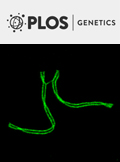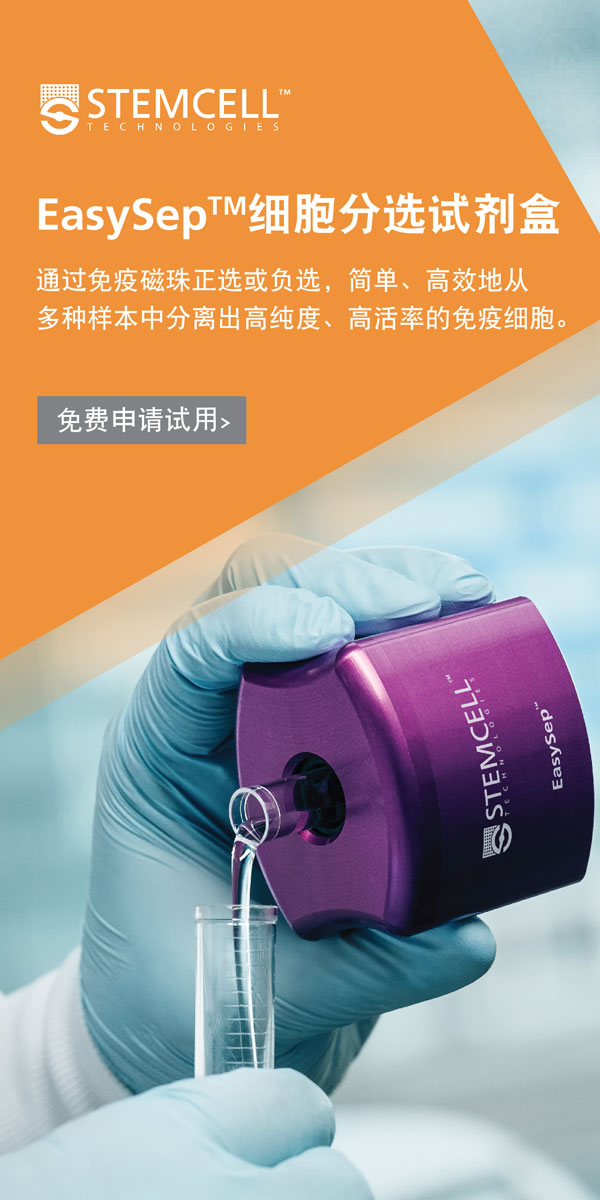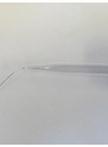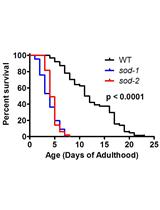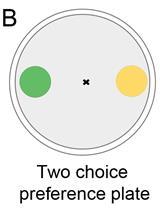- EN - English
- CN - 中文
Amplex Red Assay for Measuring Hydrogen Peroxide Production from Caenorhabditis elegans
利用Amplex Red检测秀丽隐杆线虫中过氧化氢的生成
发布: 2019年11月05日第9卷第21期 DOI: 10.21769/BioProtoc.3409 浏览次数: 12602
评审: Ayush RanawadeAnonymous reviewer(s)
Abstract
Reagents such as Amplex® Red have been developed for detecting hydrogen peroxide (H2O2) and are used to measure the release of H2O2 from biological samples such as mammalian leukocytes undergoing the oxidative burst. Caenorhabditis elegans is commonly used as a model host in the study of interactions with microbial pathogens and releases reactive oxygen species (ROS) as a component of its defense response. We adapted the Amplex® Red Hydrogen Peroxide/Peroxidase Assay Kit to measure H2O2 output from live Caenorhabditis elegans exposed to microbial pathogens. The assay differs from other forms of ROS detection in the worm, like dihydrofluorescein dyes and genetically encoded probes such as HyPer, in that it generally detects released, extracellular ROS rather than intracellular ROS, though the distinction between the two is blurred by the fact that certain species of ROS, including H2O2, can cross membranes. The protocol involves feeding C. elegans on a lawn of the pathogen of interest for a period of time. The animals are then rinsed off the plates in buffer and washed to remove any microbes on their cuticle. Finally, the animals in buffer are distributed into 96-well plates and Amplex® Red and horseradish peroxidase (HRP) are added. Any H2O2 released into the buffer by the worms will react with the Amplex® Red reagent in a 1:1 ratio in the presence of HRP to produce the red fluorescent excitation product resorufin that can be measured fluorometrically or spectrophotometrically, and the amount of H2O2 released can be calculated by comparison to a standard curve. The assay is most appropriate for studies focused on released ROS, and its advantages include ease of use, the ability to use small numbers of animals in a plate reader assay in which measurements can be taken either fluorometrically or spectrophotometrically.
Keywords: Amplex (Amplex)Background
Interest in developing assays to study the amount and type of reactive oxygen species produced by C. elegans was primarily driven by the use of this model organism in studies focused on aging and infection. Oxidative damage caused by ROS has long been hypothesized to contribute to aging, and therefore measuring the intracellular oxidative environment and how it changes over time and in various aging mutants is relevant. Likewise, ROS are generated during the C. elegans immune response where they are capable of acting as signaling or effector molecules. Understanding the sources of ROS and being able to measure their magnitude is therefore of key importance (reviewed by [Labuschagne and Brenkman, 2013; McCallum and Garsin, 2016; Miranda-Vizuete and Veal, 2017]). Commonly used methods to measure ROS in C. elegans include dihydrofluorescein dyes, the genetically encoded HyPer probe, and the Amplex® Red assay. Additional methods with more specific applications include MioSox, a modified dihydroethidium (DHE) that is specific for measuring ROS in the mitochondria, and the Grx1-roGFP2 genetically-encoded probe that measures changes in redox potential (Labuschagne and Brenkman, 2013). All current methodologies that measure ROS have caveats that must be carefully considered when deciding what method to use and how to interpret the results.
The dihydrofluorescein dyes, including 2,7-dichlorodihydrofluorescein diacetate (H2DCFDA) commonly used in C. elegans, are colorless and membrane permeable in the reduced form, but become fluorescent and non-membrane permeable when oxidized. Therefore, these dyes can penetrate the cytoplasmic membrane and provide a decent measure of intracellular ROS (Labuschagne and Brenkman, 2013). However, to measure the fluorescence from C. elegans using a plate reader, a large number of animals (1,000) are required (Schulz et al., 2007; Ewald et al., 2017). Alternatively, animals can be visualized using fluorescence microscopy (Sem and Rhen, 2012). Two disadvantages to H2DCFDA include the fact that it is not specific to H2O2, and it may exert free radical properties, contributing to the generation of ROS in addition to its measurement (Labuschagne and Brenkman, 2013; Dikalov and Harrison, 2014).
HyPer, in contrast, is considered very specific to H2O2. It consists of a cpYFP (circularly permuted yellow fluorescent protein) inserted into the regulatory domain of OxyR-RD and placed under the control of aC. elegans promoter. Both tissue-specific promoters and non-specific promoters have been utilized in the worm depending on the application (Back et al., 2012; Knoefler et al., 2012). The sensor works based on the formation of an intramolecular disulfide bond that occurs upon interaction with H2O2. The strength of the two fluorescent emission peaks released by HyPer changes upon formation of the disulfide bond; one decreases and the other increases in a proportionate manner (Belousov et al., 2006). The advantage of such a ratiometric approach is that quantification can be done independently of the expression levels of the protein and therefore no normalization is required (Labuschagne and Brenkman, 2013). An additional advantage is the ability to monitor hydrogen peroxide levels over time and observe both increases and decreases. Disadvantages include the fact that HyPer is sensitive to pH changes and overexpression of these probes can significantly affect H2O2 redox signaling of the cell potentially confounding results. Furthermore, measuring the emission peaks requires sophisticated microscopy of individual animals or large numbers of animals (1,000/sample) to obtain accurate results from a plate reader (Labuschagne and Brenkman, 2013; Dikalov and Harrison, 2014; Ewald et al., 2017).
The Amplex® Red assay is based on the oxidation of 10-acetyl-3,7- dihydroxypenoxazine, which is catalyzed by horseradish peroxidase (HRP) in the presence of H2O2 to produce a red fluorescent oxidation product, resorufin, at a 1:1 ratio (Figure 1). Resorufin can be measured both fluorometrically and spectrophotometrically, though the fluorescent measurements are more sensitive and can detect lower levels of H2O2 (Mohanty et al., 1997). The Amplex® Red Hydrogen Peroxide/Peroxidase Assay Kit was first adapted to C. elegans by our group to measure the output of ROS following exposure to microbial pathogens (Chavez et al., 2007; Chavez et al., 2009; Tiller and Garsin, 2014; van der Hoeven, et al., 2015; Liu et al., 2019). The assay measures the amount of H2O2 excreted by the worm into the surrounding medium. The major source of ROS during this response appears to be an NADPH oxidase called BLI-3, which is found in the hypodermis (skin), intestine and pharynx (Edens et al., 2001; Chavezet al., 2007 and 2019; van der Hoeven et al., 2015). BLI-3 is a member of the dual oxidase (DUOX) family of proteins, which all feature a peroxidase domain in addition to an NADPH oxidase domain that generates H2O2 rather than superoxide (Aguirre and Lambeth, 2010). Bioinformatic predictions and experimental evidence indicate that BLI-3 is located in the cytoplasmic membranes of the tissue in which it is produced and oriented in a manner such that H2O2 will be excreted into extracellular environments (Edens et al., 2001; Chavez et al., 2009; Aguirre and Lambeth, 2010; Moribe et al., 2012; van der Hoeven et al., 2015). Based on the localization of BLI-3, H2O2 is released from the hypodermal surface and into the lumen of the GI tract whereupon it is excreted due to the defecation cycle that the animals continuously undergo. When measuring H2O2 from animals exposed to pathogen, the levels can be significantly, but not completely, suppressed by the addition of an NADPH oxidase inhibitor (Chavez et al., 2007 and 2009). These results suggest that there are additional sources of ROS during infection that are contributing the pool of H2O2 that is being measured. A likely source is the mitochondria, which are known to become dysfunctional during pathogen assault (Pellegrino et al., 2014), and ROS generated from this source in the form of H2O2 would be able to cross membranes and contribute to the extracellular pools. Advantages to using the Amplex® Red assay for measuring ROS in the worm include the fact that it is specific to H2O2, it can be done on samples containing as few as 30 worms in a plate reader, and it does not require sophisticated genetics or microscopy (Labuschagne and Brenkman, 2013; Tiller and Garsin, 2014). Disadvantages include the fact that there is no tissue specificity and one must be careful to maintain samples in the dark, as resorurfin is light sensitive (Labuschagne and Brenkman, 2013). Herein, we present a detailed protocol of our adaption of the Amplex® Red Hydrogen Peroxide/Peroxidase Assay Kit to measuring H2O2 output from the worm following pathogen exposure.

Figure 1. Conversion of Amplex Red to Resorufin in the presence of H2O2 and horseradish peroxidase (HRP)
Materials and Reagents
- 96-well microplate, black, clear bottom with lid (Corning costar, catalog number: 3603)
- 60 mm Petri dish (Fisher Scientific, catalog number: FB0875713A)
- 1.7 ml microcentrifuge tube
- 15 ml conical tube
- Micropipette tips
- PluriStrainer 10 μm (pluriSelect, catalog number: 43-50010-01)
- Serological pipettes
- Caenorhabditis elegans wild-type N2 strain (Caenorhabditis Genetics Center, University of Minnesota)
- Escherichia coli OP50 strain (Caenorhabditis Genetics Center, University of Minnesota)
- Enterococcus faecalis OG1RF strain (ATCC 47077)
- Autoclaved distilled water
- Cholesterol (Sigma-Aldrich, catalog number: C-8503)
- Absolute ethanol (Fisher, catalog number: BP2818-4)
- Sodium chloride (NaCl) (Fisher, catalog number: S271-500)
- Peptone (Becton, Dickinson and Company, catalog number: 211677)
- Agar (Becton, Dickinson and Company, catalog number: 214530)
- Calcium chloride (CaCl2) (EMD, catalog number: 3000)
- Magnesium sulfate (MgSO4) (EMD, catalog number: MX0070-1)
- Potassium phosphate, dibasic (K2HPO4) (Sigma-Aldrich, catalog number: P3786)
- Potassium phosphate, monobasic (KH2PO4) (Sigma-Aldrich, catalog number: 795488)
- Sodium phosphate dibasic (Na2HPO4) (Sigma-Aldrich, catalog number: S3264)
- Nystatin (EMD Millipore, catalog number: 475914-1GM)
- Gentamicin sulfate (Sigma-Aldrich, catalog number: G3632-5G)
- Horse radish peroxidase (part of kit: Invitrogen, catalog number: A22188)
- Dimethyl sulfoxide
- Amplex® Red hydrogen peroxide/peroxidase assay kit (Invitrogen, catalog number: A22188)
- Hydrogen peroxide (VWR, catalog number: VW3540-2)
- Brain heart infusion powder (Becton, Dickinson and Company, catalog number: 211059)
- Luria-Bertani powder (Becton, Dickinson and Company, catalog number: 244620)
- Brain heart infusion (BHI) agar plates with gentamicin (50 μg/ml), made from BHI powder with agar added. Autoclaved, cooled, gentamycin added before pouring
- Brain heart infusion (BHI) broth, made from BHI powder and autoclaved.
- Nematode growth medium agar plates (see Recipes)
- M9W buffer (see Recipes)
- 50 mg/ml gentamicin sulfate (see Recipes)
- 10 mg/ml nystatin (see Recipes)
- 5 mg/ml cholesterol (see Recipes)
- Potassium Phosphate Buffer (1 M, pH 6.0) (see Recipes)
Equipment
- Micropipettes
- Fluorescence and absorbance microplate reader (Biotek, Cytation 5 multimode reader)
- Incubators for stable temperatures; 20 °C, 25 °C, 37 °C
- Tabletop centrifuge
- Stereo microscope (Zeiss, Stemi 2000)
- Vortex mixer
- Autoclave
Software
- Gen5 (Biotek, https://www.biotek.com/products/software-robotics-software/gen5-microplate-reader-and-imager-software/)
- Microsoft Excel (Microsoft, https://products.office.com/en-us/excel)
- GraphPad Prism (GraphPad, https://www.graphpad.com/scientific-software/prism/)
Procedure
文章信息
版权信息
© 2019 The Authors; exclusive licensee Bio-protocol LLC.
如何引用
Karakuzu, O., Cruz, M. R., Liu, Y. and Garsin, D. A. (2019). Amplex Red Assay for Measuring Hydrogen Peroxide Production from Caenorhabditis elegans. Bio-protocol 9(21): e3409. DOI: 10.21769/BioProtoc.3409.
分类
免疫学 > 宿主防御 > 蠕虫
微生物学 > 微生物-宿主相互作用 > 体内实验模型 > 蠕虫
生物化学 > 其它化合物 > 活性氧
您对这篇实验方法有问题吗?
在此处发布您的问题,我们将邀请本文作者来回答。同时,我们会将您的问题发布到Bio-protocol Exchange,以便寻求社区成员的帮助。
Share
Bluesky
X
Copy link


